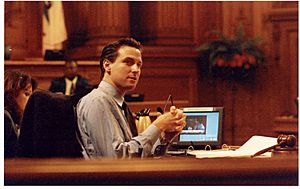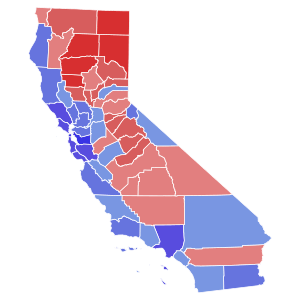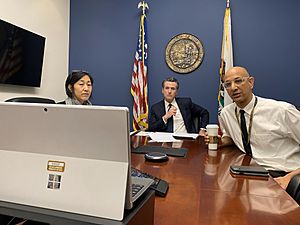Gavin Newsom facts for kids
Quick facts for kids
Gavin Newsom
|
|
|---|---|
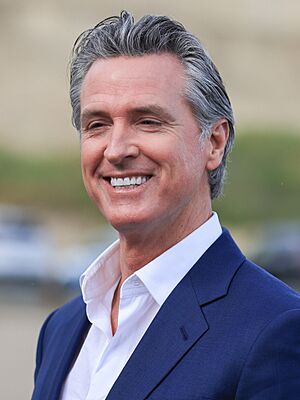
Newsom in 2024
|
|
| 40th Governor of California | |
| Assumed office January 7, 2019 |
|
| Lieutenant | Eleni Kounalakis |
| Preceded by | Jerry Brown |
| 49th Lieutenant Governor of California | |
| In office January 10, 2011 – January 7, 2019 |
|
| Governor | Jerry Brown |
| Preceded by | Abel Maldonado |
| Succeeded by | Eleni Kounalakis |
| 42nd Mayor of San Francisco | |
| In office January 8, 2004 – January 10, 2011 |
|
| Preceded by | Willie Brown |
| Succeeded by | Ed Lee |
| Member of the San Francisco Board of Supervisors from the 2nd district |
|
| In office January 8, 1997 – January 8, 2004 |
|
| Preceded by | Kevin Shelley |
| Succeeded by | Michela Alioto-Pier |
| Personal details | |
| Born |
Gavin Christopher Newsom
October 10, 1967 San Francisco, California, U.S. |
| Political party | Democratic |
| Spouses |
|
| Children | 4 |
| Parent |
|
| Residences | Fair Oaks, California Kentfield, California |
| Education | Santa Clara University (BS) |
| Signature | |
Gavin Christopher Newsom (born October 10, 1967) is an American politician and businessman. Since 2019, he has been the 40th governor of California. Before becoming governor, he served as the Lieutenant Governor of California and the Mayor of San Francisco.
Contents
Early Life and Education
Newsom was born in San Francisco, California. His father, William Alfred Newsom III, was a judge and lawyer. Gavin is a fourth-generation San Franciscan. His family had an otter as a pet.
Newsom has shared that he faced challenges growing up due to dyslexia. This learning difference made it hard for him to write, spell, read, and work with numbers. He often used audiobooks and verbal lessons to learn. Even today, he prefers to listen to reports and documents.
He played basketball and baseball in high school. He graduated from Redwood High School in 1985. His mother worked hard to support him and his sister. She also welcomed foster children into their home, which taught Newsom about helping others.
Newsom attended Santa Clara University on a partial baseball scholarship. He graduated in 1989 with a degree in political science. He played baseball for two years but had to stop due to an arm injury. He enjoyed his time at Santa Clara, saying the school helped him think for himself and question ideas.
Business Career
In 1991, Newsom and his partners started a company called PlumpJack Associates L.P. They opened the PlumpJack Winery in 1992 with help from a family friend, Gordon Getty. Getty invested in many of Newsom's businesses because he saw potential in them.
Newsom once had a funny experience with government rules. The San Francisco Health Department wanted his wine store to install a sink for a mop. He thought this was unnecessary for a carpeted wine shop. This experience made him want to fix confusing rules when he later became a politician.
His business grew to employ over 700 people. He opened several restaurants and stores, including the PlumpJack Café and the Balboa Café Bar and Grill. Newsom believed in trying new ideas, even if they failed. He would give gift certificates to employees whose business ideas didn't work out, saying, "There can be no success without failure."
When Newsom became mayor in 2004, he sold his share of his San Francisco businesses. However, he kept ownership in his PlumpJack companies outside San Francisco, like the winery in Napa Valley.
Political Career
Newsom began his political journey in 1996. The mayor of San Francisco, Willie Brown, appointed him to a city commission. The next year, Newsom joined the Board of Supervisors. He was elected to the board three times.
As a Supervisor, Newsom worked to improve the city's public transportation system, Muni. He also supported banning tobacco ads visible from streets. He helped create housing projects to increase homeownership and affordable housing in San Francisco.
His most well-known achievement as a supervisor was an initiative called Care Not Cash. This program offered housing, drug treatment, and health support to homeless people instead of just giving them money. Many people supported this idea, and it helped him become a strong candidate for mayor. An audit later showed the program was very successful.
Mayor of San Francisco (2004–2011)
In 2003, at 36 years old, Newsom became the 42nd mayor of San Francisco. He was the youngest mayor in the city in a century. He was reelected in 2007.
As mayor, Newsom continued to work on the Care Not Cash program. This led to thousands of homeless people finding permanent shelter and affordable housing. He also started programs like Project Homeless Connect to help more people.
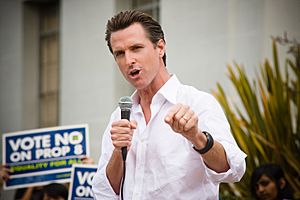
In 2007, he signed a law to create Healthy San Francisco. This program provided universal health care for city residents, making San Francisco the first city in the U.S. to do so. He also worked to make healthy food and physical activity options more available for children and families.
Newsom gained national attention in 2004 when he allowed marriage licenses to be given to same-sex couples in San Francisco. This action brought a lot of attention to the issue of same-sex marriage across the country. He later opposed Proposition 8, a ballot measure that tried to stop same-sex marriage in California.
In 2010, he was named "America's Most Social Mayor" for his use of social media.
Lieutenant Governor of California (2011–2019)
Newsom was elected Lieutenant Governor of California in 2010 and reelected in 2014.
As Lieutenant Governor, Newsom supported efforts to end the death penalty in California. He believed it would save the state money and was not fair.
He also worked to improve education. He pushed for programs that would offer free community college education. He also helped secure funding to expand computer science education for all students in California, starting as early as kindergarten. Newsom also worked on reforms at the University of California to help student-athletes with their academics and injuries.
In 2013, Newsom released a book called Citizenville: How to Take the Town Square Digital and Reinvent Government. The book talks about how technology can help people get more involved in government. He later helped launch the California Report Card, an online tool where people can "grade" their state on important issues.
Governor of California (2019–present)
Newsom announced his campaign for governor in 2015. He won the election in November 2018, becoming the governor of California on January 7, 2019. He was reelected for a second term in 2022.
COVID-19 Pandemic Response
In March 2020, Newsom declared a state of emergency due to the COVID-19 pandemic. This helped California prepare for and control the virus. He focused on helping homeless people move indoors to protect them.
He issued orders for schools to decide on closures and made sure students still received meals and had access to remote learning. He also asked people 65 and older to stay home and encouraged bars and restaurants to close or offer only take-out meals. On March 19, a statewide stay-at-home order became mandatory.
Newsom worked with governors from Oregon and Washington to plan how to reopen their economies safely. He emphasized that reopening would be based on scientific data, not specific dates. In June 2020, he made face coverings mandatory for all Californians to help stop the virus from spreading.
California's vaccination rate increased significantly, with over half the population fully vaccinated by September 2021.
Wildfires
California often faces wildfires. In March 2020, Newsom declared a state of emergency to prepare for the 2020 wildfire season. He reported that the state was fighting many fires, some started by thunderstorms.
Newsom's administration has worked on projects to reduce wildfire risks. These projects include clearing land to create "fuel breaks" that can slow down fires. He has also focused on improving how the state handles environmental reviews for fire prevention projects.
Energy and Environment
Newsom has focused on protecting the environment and fighting climate change. In 2019, he worked to keep environmental protections in California that were being changed at the national level. He also sued federal agencies to protect fish in the Sacramento–San Joaquin River Delta.
He attended the 2019 UN Climate Action Summit to talk about California's efforts in climate leadership. In September 2020, he signed an order to stop selling gasoline-powered vehicles in California by 2035. This means all new passenger vehicles sold in the state will need to be zero-emission.
Newsom has also addressed oil drilling in California. He put a temporary stop on new drilling permits to allow for review by scientists. In 2021, he committed to ending the sale of new gas leases by 2024 and stopping all oil extraction by 2045. He also proposed creating a safety zone around new drilling sites near populated areas.
Gun Control
As Lieutenant Governor, Newsom supported gun control regulations. He pushed for background checks for people buying ammunition. He believes in the Second Amendment but also wants national cooperation to control dangerous weapons.
In 2021, after a judge struck down California's ban on assault weapons, Newsom proposed new laws. He signed bills in 2022 to restrict privately made "ghost guns" and to stop the marketing of firearms to children. He also signed a law allowing private citizens to sue those who illegally import, distribute, manufacture, or sell illegal firearms in California.
Health Care
Newsom has worked to lower health care costs and make it easier for people to get health care. He supports creating a universal state health care system. His administration expanded health care eligibility for young adults and older residents, regardless of their immigration status. By 2024, California aims to guarantee health care to all low-income adults.
Infrastructure and Development
Newsom has focused on improving California's infrastructure.
High-Speed Rail
Newsom announced that while some work would continue on the California High-Speed Rail project, other parts would be delayed due to high costs and delays.
Homelessness and Housing Shortage
Newsom has made addressing homelessness and the housing shortage a top priority. He has pushed communities to build more affordable housing. He opposes the "NIMBY" (not-in-my-back-yard) mindset, saying it harms the state.
He signed laws to make it easier to build different types of housing, like duplexes and fourplexes, in areas that used to be only for single-family homes. He also streamlined the process for building student and faculty housing at colleges. In 2022, he signed 39 bills to help solve California's housing crisis, including removing minimum parking requirements near public transport and allowing housing on some commercial lots.
Water Management
Newsom supports agreements to manage California's water resources. These agreements aim to resolve disagreements between farmers, cities, and environmental groups about how much water should remain in the state's important rivers, the Sacramento and San Joaquin.
Native American Relations
In June 2019, Newsom apologized to Native American representatives for the past actions of the California state government, which led to the killing of many Native Americans in the 19th century. He called these events a "genocide" and said they should be described that way in history books. In 2024, he signed a law banning offensive Native American mascots and team names in K-12 schools.
Personal Life
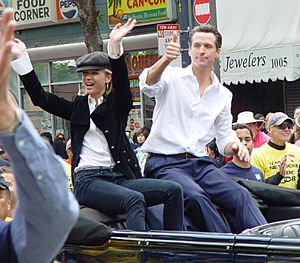
Newsom was raised in the Catholic faith and identifies as a practicing Catholic. He has spoken about his strong faith.
In 2001, Newsom married Kimberly Guilfoyle. They divorced in 2006.
Newsom began dating film director Jennifer Siebel in 2006. They got engaged in 2007 and married in 2008. They have four children together.
Newsom and his family moved from San Francisco to Kentfield in Marin County in 2012. After he was elected governor, they moved into the California Governor's Mansion in Sacramento. They later settled in Fair Oaks, California.
Works
- Gavin Newsom (2013; co-authored with Lisa Dickey). Citizenville: How to Take the Town Square Digital and Reinvent Government. London: Penguin Group. ISBN: 978-0-1431-2447-4. .
See also
 In Spanish: Gavin Newsom para niños
In Spanish: Gavin Newsom para niños
- Electoral history of Gavin Newsom


